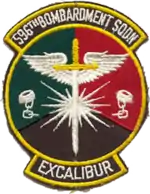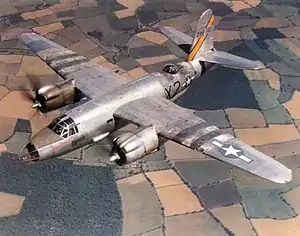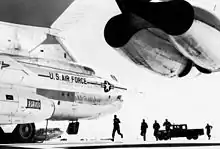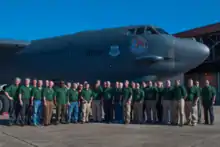| 596th Bombardment Squadron | |
|---|---|
_(2).jpg.webp) 596th Squadron Boeing B-52[lower-alpha 1] | |
| Active | 1943–1945; 1963–1993 |
| Country | |
| Branch | |
| Role | Bombardment |
| Motto(s) | Excalibur |
| Engagements | European Theater of Operations Gulf War |
| Decorations | Distinguished Unit Citation Air Force Outstanding Unit Award |
| Insignia | |
| Patch with 596th Bomb Squadron emblem[lower-alpha 2][1] |  |
| World War II group tail marking[2] | Yellow diagonal stripe |
| World War II squadron fuselage code[2] | X2 |
The 596th Bomb Squadron is an inactive United States Air Force unit. It was last assigned to the 2d Operations Group at Barksdale Air Force Base, Louisiana, where it was inactivated on 1 October 1993, and its resources transferred to another unit.
The squadron was first activated in April 1943 as the 596th Bombardment Squadron and equipped with Martin B-26 Marauders. It departed for the European Theater of Operations in the spring of 1944. From bases in England, and later on the European continent, it participated in combat until late April 1945, and was awarded a Distinguished Unit Citation for its actions. It remained in Europe after V-E Day until the end of 1945, when it returned to the United States and was inactivated at the Port of Embarkation.
The squadron was again activated in February 1963, when it assumed the personnel and Boeing B-52 Stratofortresses of another unit at Dow Air Force Base, Maine. It stood alert and flew training missions until 1968, when Dow closed and it moved to Barksdale Air Force Base, Louisiana. It participated in the longest strike mission in history at the start of Desert Storm, flying from Barksdale to its launch position near Iraq.
History
World War II
The squadron was established at MacDill Field, Florida in April 1943 as one of the original squadrons of the 397th Bombardment Group, a B-26 Marauder medium bomber group.[1][3] It drew its initial cadre from the 21st Bombardment Group.[4] The squadron trained under Third Air Force at stations in the southeastern United States. After completing its training by participating in the Tennessee Maneuvers, the squadron departed Hunter Field, Georgia for the European Theater of Operations on 13 March 1944.[1][4]
The squadron was temporarily stationed at RAF Gosfield upon its arrival in England in early April 1944. On the 15th of the month, its parent group displaced the 363d Fighter Group at RAF Rivenhall and the unit flew its first combat mission five days later.[3][5] In preparation for Operation Overlord, the invasion of Normandy, the squadron participated in Operation Crossbow, attacking V-1 flying bomb launch pads. It also struck bridges, coastal defenses, marshalling yards and airfields in northern France. On D-Day the squadron attacked strong points and bombed fuel dumps and other objectives to support ground forces throughout the Normandy Campaign.[3]

In July 1944, the squadron participated in Operation Cobra, attacking German forces near Saint Lo, France, during the Allied breakout there. In August, the squadron moved from England to Gorges Airfield, an Advanced Landing Ground in France. From there it attacked naval targets at Saint Malo and Brest. Once on the Continent, the squadron made frequent moves forward as the Allied forces advanced during the Northern France Campaign. By September the squadron began flying missions into Germany, attacking depots and defended areas.[3]
During the Battle of the Bulge, the squadron struck enemy lines of communication. On 23 December 1944 the unit severed a railway bridge at Ediger-Eller, Germany, despite heavy flak and fighter opposition from the Luftwaffe. For this action it was awarded a Distinguished Unit Citation. The squadron continued to fly missions to support the Allied drive into Germany until 20 April 1945, exactly one year after its first combat mission, having completed 239 combat missions.[3][6]
After V-E Day the squadron returned to its former base at Peronne Airfield, France, and remained there until December, when it returned to the United States. Upon arrival at Camp Shanks, New York in early January 1946, the squadron was inactivated.[1]
B-52 operations

Starting in the late 1950s, Strategic Air Command (SAC) dispersed its Boeing B-52 Stratofortress bombers over a larger number of bases, thus making it more difficult for the Soviet Union to knock out the entire fleet with a surprise first strike.[7] SAC established "Strategic Wings" to command this dispersed fleet. however, these wings were Major Command controlled (MAJCON) units and could not carry a permanent history or lineage.[8] SAC received authority to replace its strategic wings that were equipped with combat aircraft with Air Force controlled (AFCON) units, which could carry a lineage and history. As part of this program, in February 1963, the 397th Bombardment Wing replaced the 4038th Strategic Wing at Dow Air Force Base, Maine.[9] In this reorganization the 596th was reactivated and assumed the personnel, mission, and Boeing B-52G Stratofortresses of the 341st Bombardment Squadron, which was simultaneously inactivated.[1][10][lower-alpha 4]
It carried out operational training missions with the 397th Wing at Dow. Half of the squadron's aircraft were maintained on fifteen minute alert, fully fueled and ready for combat to reduce vulnerability to a Soviet missile strike.[11] The squadron continued to maintain an alert commitment until President Bush terminated the alert program at the end of the Cold War. SAC also maintained an airborne force for "airborne alert training" (Operation Chrome Dome)[12] and the squadron was periodically tasked for this mission. Accidents at Palomares in January 1966 and Thule in January 1968 contributed to the end of Chrome Dome, as did rapidly rising costs of the programs and the use of strategic bombers for non-nuclear missions, but the primary reason was the availability of a survivable intercontinental ballistic missile force.[13]
In April 1968, the 397th Wing was inactivated in preparation for the turnover of Dow to the Maine Air National Guard.[9] The squadron moved to Barksdale Air Force Base, Louisiana where it was assigned to the 2d Bombardment Wing. Although the squadron did not participate in the Vietnam War as a unit, it deployed personnel and aircraft to participate in operations in Southeast Asia, including Operation Linebacker. For a year and a half, from the end of May 1972 until late October 1973, the squadron was not operational due to these deployments.[14][15]

The squadron deployed aircraft and personnel to the 801st Bombardment Wing (Provisional), Morón Air Base, Spain and augmented the 1708th Bombardment Wing, Provisional at Prince Abdullah Air Base, Saudi Arabia, from August 1990 to March 1991 in support of Operation Desert Storm. On the first day of the war, elements of the squadron participated in Operation Senior Surprise,[lower-alpha 5] which was led by the 596th's commander, Lt Col John Beard. Seven squadron bombers launched from Barksdale and struck power and communications targets in Iraq with AGM-86 ALCM missiles, returning to Barksdale 35 hours later.[16]
On 1 September 1991, SAC reorganized its combat wings under the Objective Wing model. The 2nd Operations Group was activated and the 2nd Wing's operational elements were assigned to it. At the same time, the squadron name changed to the 596th Bomb Squadron. The 596th was inactivated and transferred its personnel and equipment to the 96th Bomb Squadron, which was activated in its place on 1 October 1993.
Lineage
- Constituted as the 596th Bombardment Squadron (Medium) on 20 March 1943
- Activated on 20 April 1943
- Redesignated 596th Bombardment Squadron, Medium c. April 1944
- Inactivated on 31 December 1945
- Redesignated 596th Bombardment Squadron, Heavy and activated on 15 November 1962 (not organized)
- Organized on 1 February 1963[17]
- Redesignated 596th Bomb Squadron on 1 September 1991
- Inactivated on 1 October 1993
Assignments
- 397th Bombardment Group, 20 April 1943 – 31 December 1945
- Strategic Air Command, 15 November 1962 (not organized)
- 397th Bombardment Wing, 1 February 1963[17] (attached to 2d Bombardment Wing after 15 April 1968)
- 2d Bombardment Wing, 25 April 1968[14][15]
- 2d Operations Group, 1 September 1991 – 1 October 1993[18]
Stations
- MacDill Field, Florida, 20 April 1943
- Avon Park Army Air Field, Florida, 14 October 1943
- Hunter Field, Georgia, 1 November 1943 – 13 March 1944
- RAF Gosfield (Station 154),[19] England, 5 April 1944
- RAF Rivenhall (Station 168),[19] England, 15 April 1944
- RAF Hurn (AAF-492),[20] England, 4 August 1944
- Gorges Airfield (A-26),[21] France, 30 August 1944
- Dreux/Vernouillet Airfield (A-41),[22] France, c. 16 September 1944
- Peronne Airfield (A-72),[23] France, c. 8 October 1944
- Venlo Airfield (Y-55),[24] Netherlands, 25 April 1945
- Peronne Airfield (A-72),[23] France, 30 May – c. December 1945
- Camp Kilmer, New Jersey, 30 – 31 December 1945
- Dow Air Force Base, Maine, 1 February 1963[17]
- Barksdale Air Force Base, Louisiana, 25 April 1968 – 1 October 1993[14]
Awards and campaigns
| Award streamer | Award | Dates | Notes |
|---|---|---|---|
| Distinguished Unit Citation | 23 December 1944 Germany | 596th Bombardment Squadron[1] | |
| Air Force Outstanding Unit Award | 1 July 1986–30 June 1987 | 596th Bombardment Squadron[25] | |
| Air Force Outstanding Unit Award | 1 July 1987–30 June 1989 | 596th Bombardment Squadron[25] |
| Campaign Streamer | Campaign | Dates | Notes | |
|---|---|---|---|---|
| Air Offensive, Europe | 5 April 1944 – 5 June 1944 | 596th Bombardment Squadron[1] | ||
| Normandy | 6 June 1944 – 24 July 1944 | 596th Bombardment Squadron[1] | ||
| Northern France | 25 July 1944 – 14 September 1944 | 596th Bombardment Squadron[1] | ||
| Rhineland | 15 September 1944 – 21 March 1945 | 596th Bombardment Squadron[1] | ||
| Ardennes-Alsace | 16 December 1944 – 25 January 1945 | 596th Bombardment Squadron[1] | ||
| Central Europe | 5 April 1944 – 21 May 1945 | 596th Bombardment Squadron[1] | ||
| Defense of Saudi Arabia | 2 August 1990–16 January 1991 | 596th Bombardment Squadron[lower-alpha 6][15] | ||
| Liberation and Defense of Kuwait | 17 January 1991–11 April 1991 | 596th Bombardment Squadron[15] |
Aircraft
- Martin B-26 Marauder, 1943–1945
- Boeing B-52 Stratofortress, 1963–1993[17]
See also
References
Notes
- ↑ Aircraft is Boeing B-52G-95-BW Stratofortress serial 58-0183 Valkyrie. This is one of seven B-52s that flew on "Secret Squirrel" on the first night of Desert Storm. It was retired to the Aerospace Maintenance and Regeneration Center less than six months later on 9 July 1991, and was later put on display at the Pima Air Museum. Baugher, Joe (21 April 2023). "1958 USAF Serial Numbers". Joe Baugher. Retrieved 3 May 2023.
- ↑ Approved 20 March 1945. Description: On a disc trisected red, brown, and green, trisection angle starting from vertical division line at top, a silver winged sword with gold hilt, guard and pommel palewise, striking with impact mark of eight white rays on either side, and cleaving shackle chains fastened to silver slave bracelets, one to dexter, one to sinister, all within a white border, edged golden orange.
- ↑ Aircraft is B-26B-55-MA Marauder, serial 42-96142, Dee-Feater, fuseage code X2-A.
- ↑ While this action was almost tantamount to redesignation, they were not official redesignations." The Development of the Strategic Air Command 1946-1986, Office of the Historian, Headquarters Strategic Air Command, Offutt AFB, NE, pp. 117-118.
- ↑ This operation was referred to as "Operation Secret Squirrel" by the participating aircrews.
- ↑ The Southwest Asia awards were made to the 2nd Bombardment Wing.
Citations
- 1 2 3 4 5 6 7 8 9 10 11 12 Maurer, Combat Squadrons, pp. 677–678
- 1 2 Watkins, pp. 112–113
- 1 2 3 4 5 Maurer, Combat Units, pp. 283–284
- 1 2 "Abstract, History 397 bombardment Group April 1943 – March 1944". Air Force History Index. Retrieved 25 September 2015.
- ↑ "Abstract, History 397 Bombardment Group Apr–May 1944". Air Force History Index. Retrieved 25 September 2015.
- ↑ "Abstract, History 397 Bombardment Group Apr 1945". Air Force History Index. Retrieved 25 September 2015.
- ↑ "Abstract (Unclassified), Vol 1, History of Strategic Air Command, Jan-Jun 1957 (Secret)". Air Force History Index. Retrieved 4 March 2014.
- ↑ Ravenstein, Charles A. (1984). A Guide to Air Force Lineage and Honors (2d, Revised ed.). Maxwell AFB, AL: USAF Historical Research Center. p. 12.
- 1 2 Ravenstein, Air Force Wings, p. 213
- ↑ Maurer, Combat Squadrons, pp. 422-423
- ↑ "Abstract (Unclassified), History of the Strategic Bomber since 1945 (Top Secret, downgraded to Secret)". Air Force History Index. 1 April 1975. Retrieved 4 March 2014.
- ↑ Narducci, pp. 5-6
- ↑ Narducci, p. 17
- 1 2 3 Ravenstein, Air Force Wings. pp. 7–8
- 1 2 3 4 Bailey, Carl E. (14 August 2017). "Factsheet 2 Bomb Wing (ACC)". Air Force Historical Research Agency. Retrieved 4 May 2023.
- ↑ Rogoway, Tyler (18 January 2016). "Operation Secret Squirrel Saw B-52s Rippling Off Cruise Missiles At Iraq 25 Years Ago". Jalopnik. Retrieved 4 May 2023.
- 1 2 3 4 Lineage, including assignments, stations and aircraft through 1963 in Maurer, Combat Squadrons, pp. 677–678
- ↑ Haulman, Daniel (27 September 2017). "Factsheet 2 Operations Group (ACC)". Air Force Historical Research Agency. Retrieved 4 May 2023.
- 1 2 Station number in Anderson, p. 22
- ↑ Station number in Anderson, p. 33
- ↑ Station number in Johnson. p. 15
- ↑ Station number in Johnson, p. 17
- 1 2 Station number in Johnson, p. 21
- ↑ Station number in Johnson, p. 30
- 1 2 "Air Force Personnel Services: Unit Awards". Air Force Personnel Center. Retrieved 4 May 2023. (search)
Bibliography
![]() This article incorporates public domain material from the Air Force Historical Research Agency
This article incorporates public domain material from the Air Force Historical Research Agency
- Anderson, Capt. Barry (1985). Army Air Forces Stations: A Guide to the Stations Where U.S. Army Air Forces Personnel Served in the United Kingdom During World War II (PDF). Maxwell AFB, AL: Research Division, USAF Historical Research Center. Archived from the original (PDF) on 4 March 2016. Retrieved 7 July 2012.
- Hopkins, J. C.; Goldberg, Sheldon A. (1986). The Development of Strategic Air Command 1946-1986 (the fortieth anniversary history). Offutt AFB, NE: Office of the Historian, Strategic Air Command. Retrieved 18 February 2018.
- Johnson, 1st Lt. David C. (1988). U.S. Army Air Forces Continental Airfields (ETO) D-Day to V-E Day (PDF). Maxwell AFB, AL: Research Division, USAF Historical Research Center. Archived from the original (PDF) on 29 September 2015.
{{cite book}}: CS1 maint: numeric names: authors list (link) - Maurer, Maurer, ed. (1983) [1961]. Air Force Combat Units of World War II (PDF) (reprint ed.). Washington, DC: Office of Air Force History. ISBN 0-912799-02-1. LCCN 61060979.
- Maurer, Maurer, ed. (1982) [1969]. Combat Squadrons of the Air Force, World War II (PDF) (reprint ed.). Washington, DC: Office of Air Force History. ISBN 0-405-12194-6. LCCN 70605402. OCLC 72556.
- Narducci, Henry M. (1988). Strategic Air Command and the Alert Program: A Brief History. Offutt AFB, NE: Office of the Historian, Strategic Air Command. Retrieved 18 February 2018.
- Ravenstein, Charles A. (1984). Air Force Combat Wings, Lineage & Honors Histories 1947–1977. Washington, DC: Office of Air Force History. ISBN 0-912799-12-9.
- Watkins, Robert (2008). Battle Colors. Vol. III Insignia and Markings of the Ninth Air Force in World War II. Atglen, PA: Shiffer Publishing Ltd. ISBN 978-0-7643-2938-8.
